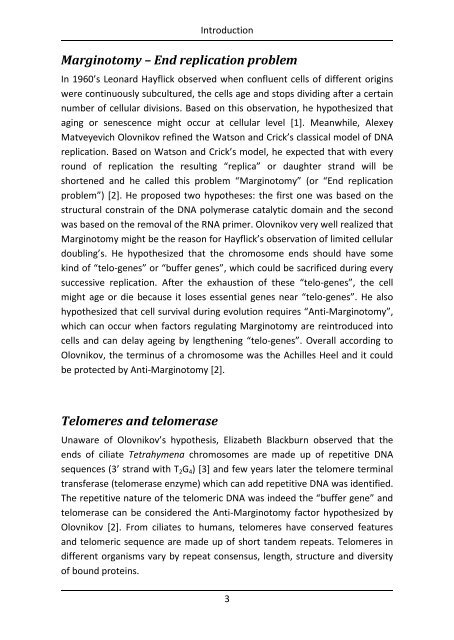View/Open - Università degli Studi di Milano-Bicocca
View/Open - Università degli Studi di Milano-Bicocca
View/Open - Università degli Studi di Milano-Bicocca
Create successful ePaper yourself
Turn your PDF publications into a flip-book with our unique Google optimized e-Paper software.
Introduction<br />
Marginotomy – End replication problem<br />
In 1960’s Leonard Hayflick observed when confluent cells of <strong>di</strong>fferent origins<br />
were continuously subcultured, the cells age and stops <strong>di</strong>vi<strong>di</strong>ng after a certain<br />
number of cellular <strong>di</strong>visions. Based on this observation, he hypothesized that<br />
aging or senescence might occur at cellular level [1]. Meanwhile, Alexey<br />
Matveyevich Olovnikov refined the Watson and Crick’s classical model of DNA<br />
replication. Based on Watson and Crick’s model, he expected that with every<br />
round of replication the resulting “replica” or daughter strand will be<br />
shortened and he called this problem “Marginotomy” (or “End replication<br />
problem”) [2]. He proposed two hypotheses: the first one was based on the<br />
structural constrain of the DNA polymerase catalytic domain and the second<br />
was based on the removal of the RNA primer. Olovnikov very well realized that<br />
Marginotomy might be the reason for Hayflick’s observation of limited cellular<br />
doubling’s. He hypothesized that the chromosome ends should have some<br />
kind of “telo-genes” or “buffer genes”, which could be sacrificed during every<br />
successive replication. After the exhaustion of these “telo-genes”, the cell<br />
might age or <strong>di</strong>e because it loses essential genes near “telo-genes”. He also<br />
hypothesized that cell survival during evolution requires “Anti-Marginotomy”,<br />
which can occur when factors regulating Marginotomy are reintroduced into<br />
cells and can delay ageing by lengthening “telo-genes”. Overall accor<strong>di</strong>ng to<br />
Olovnikov, the terminus of a chromosome was the Achilles Heel and it could<br />
be protected by Anti-Marginotomy [2].<br />
Telomeres and telomerase<br />
Unaware of Olovnikov’s hypothesis, Elizabeth Blackburn observed that the<br />
ends of ciliate Tetrahymena chromosomes are made up of repetitive DNA<br />
sequences (3’ strand with T2G4) [3] and few years later the telomere terminal<br />
transferase (telomerase enzyme) which can add repetitive DNA was identified.<br />
The repetitive nature of the telomeric DNA was indeed the “buffer gene” and<br />
telomerase can be considered the Anti-Marginotomy factor hypothesized by<br />
Olovnikov [2]. From ciliates to humans, telomeres have conserved features<br />
and telomeric sequence are made up of short tandem repeats. Telomeres in<br />
<strong>di</strong>fferent organisms vary by repeat consensus, length, structure and <strong>di</strong>versity<br />
of bound proteins.<br />
3

















